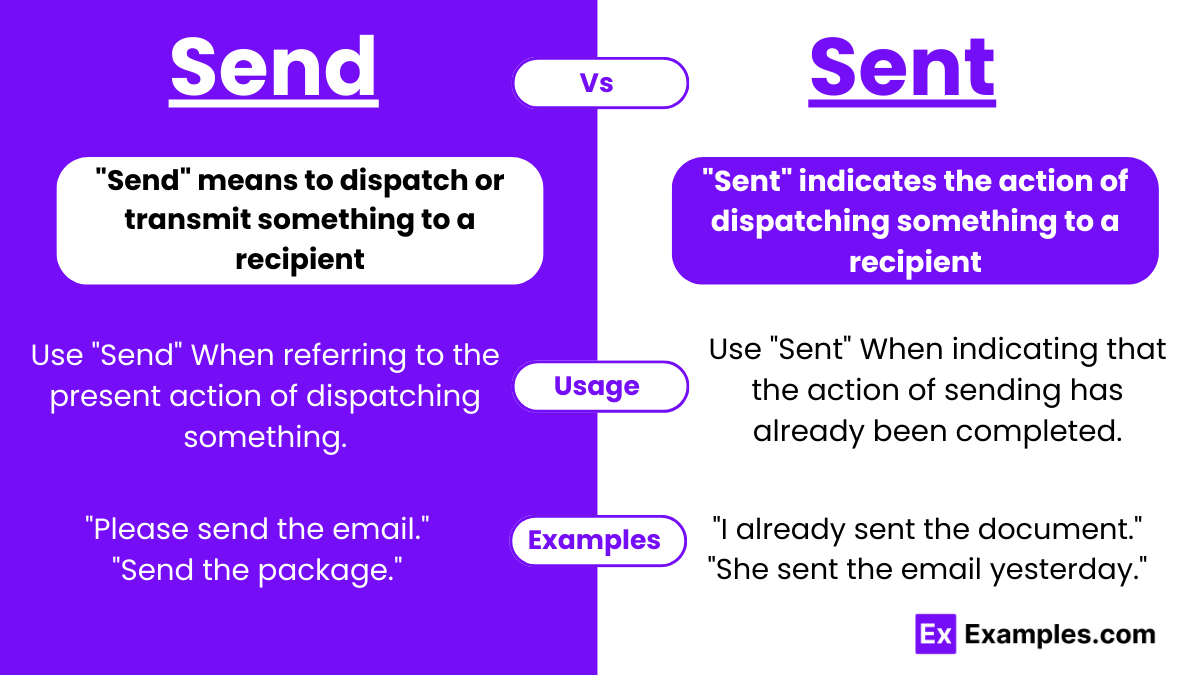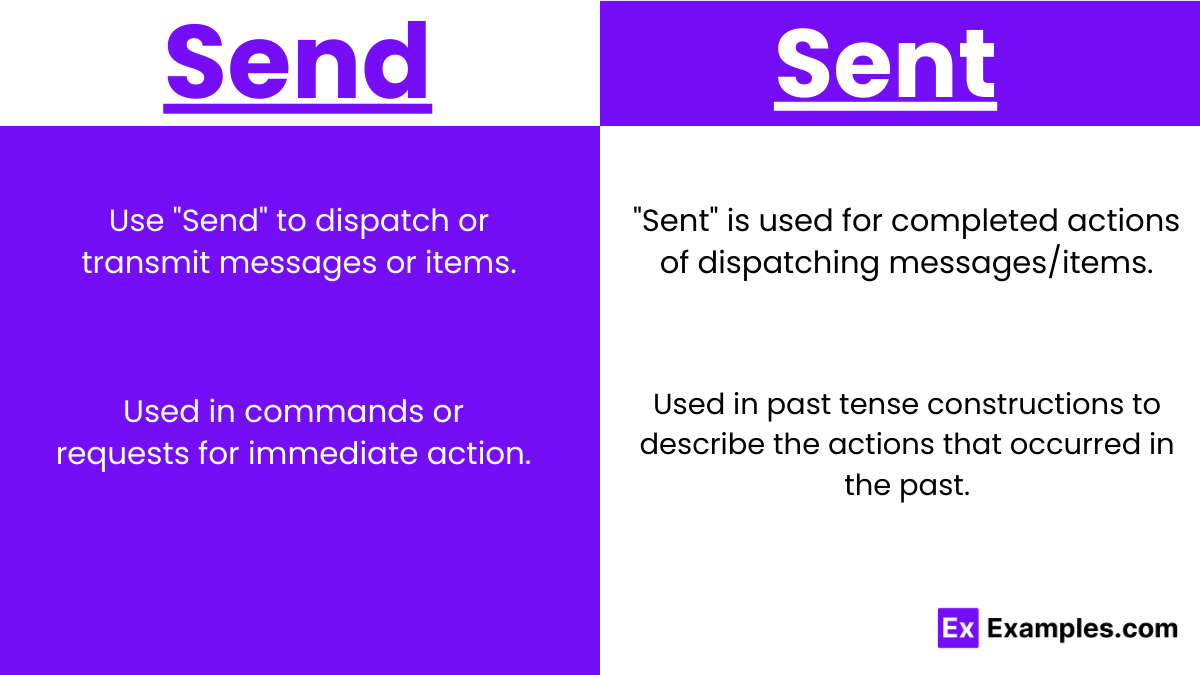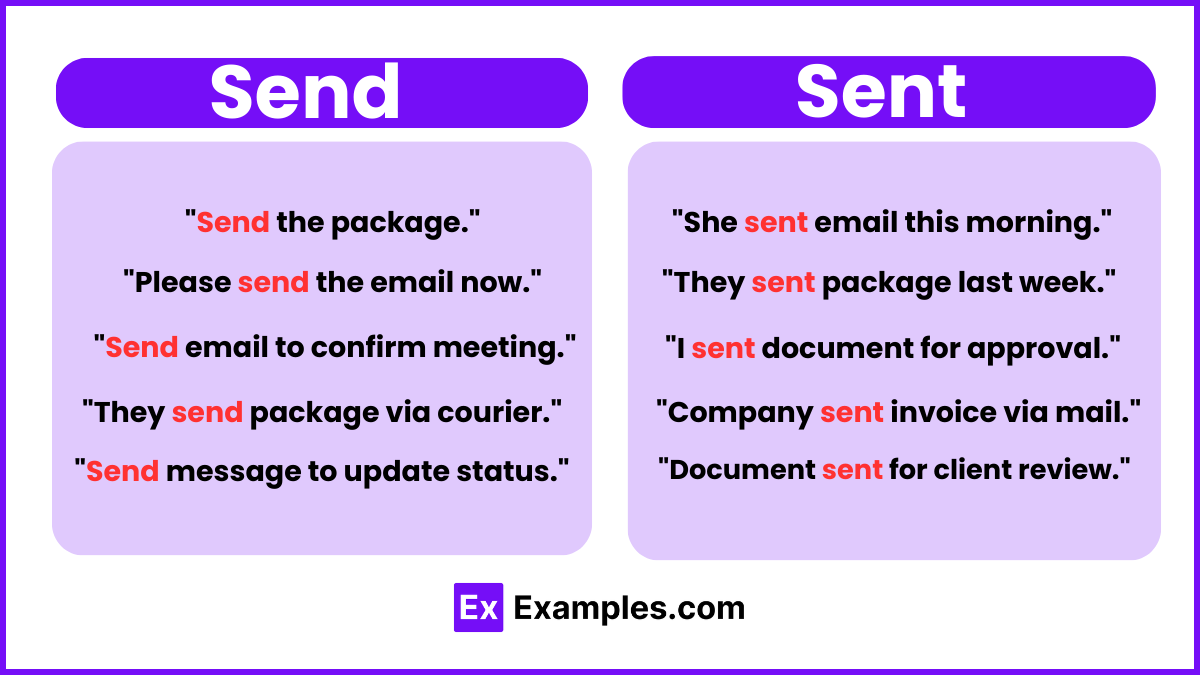Send vs Sent – Meanings, Differences, Usage, Examples
Unlock the nuances of “Send vs Sent” in this comprehensive guide to enhance your communication prowess. Delve into vivid examples illustrating the subtle disparities between these terms. From understanding their effects on clarity to mastering their application, embark on a journey to refine your linguistic finesse. Whether you’re drafting emails or crafting messages, this guide equips you with the knowledge to communicate effectively and confidently. Explore the intricate world of “Send vs Sent” and elevate your communication game today!
Send vs Sent – Meanings
- ” Send“ refers to the action of dispatching or transmitting something, such as a message, parcel, or email, from one location or person to another. It implies the initiation of communication or the movement of an object from the sender to the recipient. For instance, when you hit the “Send” button on your email client, you are initiating the transmission of the email to its intended recipient. Sending involves actively pushing information or objects from one point to another.
- Sent: On the other hand, “Sent” is the past tense and past participle form of the verb “Send.“ It indicates that the action of sending has already been completed or carried out in the past. When something has been “Sent,” it means that it has already been dispatched or transmitted from the sender to the recipient. For example, “I have sent the document to your email address” implies that the document has already been dispatched or transmitted to the specified email address.
Summary
“Send” involves the active act of dispatching or transmitting messages or items from one point to another, initiating communication or movement. Conversely, “Sent” is the past tense form of “Send,” indicating that the action of sending has already been completed. Once something has been “Sent,” it signifies that it has been dispatched or transmitted to its intended recipient, reflecting the completion of the sending process.
How To Pronounce Send and Sent
How to Pronounce “Send”:
- “Send” is pronounced as [Send].
- The pronunciation starts with the sound [s], followed by the vowel sound [ɛ], similar to the “e” in “end.”
- The pronunciation ends with the consonant sound [nd], created by the combination of the consonants [n] and [d].
How to Pronounce “Sent”:
- “Sent” is pronounced as [Sent].
- The pronunciation begins with the sound [s], followed by the vowel sound [ɛ], which is the same as in “send.”
- The pronunciation concludes with the consonant sound [nt], formed by the combination of the consonants [n] and [t].
Differences Between Send and Sent
| Aspect | Send | Sent |
|---|---|---|
| Tense | Present | Past |
| Form | Verb | Past participle of “send” |
| Action | Actively dispatching or transmitting | Indicates completed transmission |
| Example | “Please send the email.” | “I have already sent the email.” |
| Function | Initiates communication or movement | Indicates completion of sending process |
| Usage | Present tense usage | Past tense usage |
How to Remember the Differences Between “Send” and “Sent”
- Present vs. Past Action: Think of “send” as something you’re doing now, like sending an email. “Sent” is what you’ve already done in the past.
- Active vs. Passive Voice: “Send” is active, like pressing a button to send a message, while “sent” is passive, indicating the action is already completed.
- “Send” Starts Something: The word “send” starts with “S,” just like “start.” This reminds you it’s the present action. “Sent” doesn’t start with “S,” signaling it’s already done.
- Action vs. Result: Picture yourself actively sending a message for “send,” and imagine the message already delivered for “sent.”
- Verbal Drill: Practice saying both words aloud frequently to reinforce their meanings in your memory.
Tricks to Remember the Differences Between “Send” and “Sent”
- Present vs. Past: Think of “Send” as the present action of dispatching something, like hitting “send” on an email. “Sent,” however, indicates the action has already happened in the past.
- Active vs. Completed: Visualize “Send” as actively initiating the process of sending, while “Sent” represents the completion of that action, like a message already sent.
- “S” Clarity: Use the initial letter to your advantage. Remember “Send” for the present tense action, where you’re starting something, and “Sent” for the past action, where it’s already done.
- Action vs. Confirmation: Associate “Send” with the action of sending out information or objects, while “Sent” signifies that the action has been accomplished and confirmed.
- Engage Your Senses: Envision pressing the “send” button to feel the present action, and imagine the message being “sent” off to solidify the past action.
When to Use Send and Sent
Usage of “Send”:
- When referring to the present action of dispatching something. For example: “Please send the email now.”
- In commands or requests for immediate action. For instance: “Send the report to me as soon as it’s ready.”
- When discussing future actions of sending. For example: “I will send you the details tomorrow.”
Usage of “Sent”:
- When indicating that the action of sending has already been completed. For instance: “I have already sent the package.”
- In past tense constructions to describe actions that occurred in the past. For example: “She sent an invitation to the event last week.”
- In situations where the action of sending has been confirmed or acknowledged. For example: “The email was successfully sent to all recipients.”
Send and Sent Examples
Examples of “Send”:
- Please send the document to the client by tomorrow.
- Can you send me the meeting agenda for today’s discussion?
- I need to send an email to confirm our appointment.
- Don’t forget to send the package via express delivery.
- We will send the payment as soon as we receive the invoice.
Examples of “Sent”:
- I sent the application form to the HR department yesterday.
- She already sent the report to her supervisor for review.
- The company sent out a press release announcing the new product launch.
- They sent invitations to all the guests well in advance.
- The email was successfully sent to all recipients without any errors
Synonyms For Send and Sent
| Send (Verb) | Sent (Past Participle) |
|---|---|
| Dispatch | Delivered |
| Transmit | Forwarded |
| Transfer | Relayed |
| Convey | Dispatched |
| Transmit | Conveyed |
Exercise
Instructions: Fill in the blanks with the appropriate word, “send” or “sent,” to complete each sentence correctly.
- I will _______________ the email to the client tomorrow.
- Has she _______________ the package yet?
- Please _______________ the report to the manager for review.
- They have already _______________ out invitations to the event.
- He needs to _______________ a thank-you note to the donors.
- The email was successfully _______________ to all recipients.
- We _______________ the documents via courier for quick delivery.
- Have you _______________ the payment for the invoice?
Answers:
- send
- sent
- send
- sent
- send
- sent
- sent
- sent
FAQ’S
Which is correct to Sent or to Send?
The correct form is “to send.” “To send” is the infinitive form of the verb, indicating the action of dispatching something in the present or future tense.
How do I know if I should use the present tense “Send” or the past tense “Sent”?
Use “Send” for present actions or future intentions: “I will send the email tomorrow.” Use “Sent” for actions already completed in the past: “I already sent the document yesterday.”
What are some common mistakes people make when using “Send” and “Sent”?
Common mistakes include using “send” instead of “sent” for past actions and vice versa, and failing to conjugate the verb correctly according to the tense needed in the sentence.




